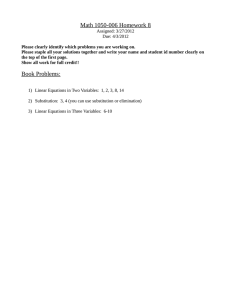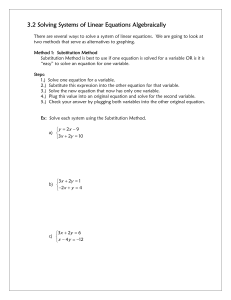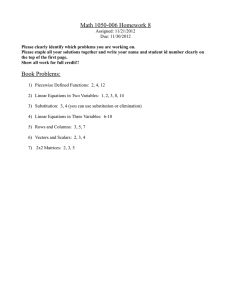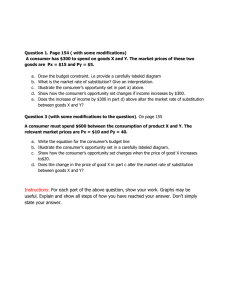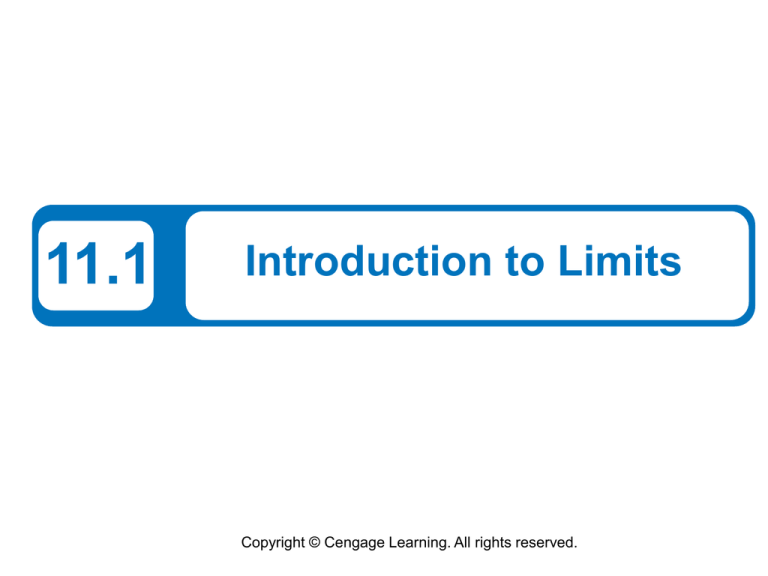
11.1
Introduction to Limits
Copyright © Cengage Learning. All rights reserved.
What You Should Learn
•
Understand the limit concept.
•
Use the definition of a limit to estimate limits.
•
Determine whether limits of functions exist.
•
Use properties of limits and direct substitution to
evaluate limits.
2
The Limit Concept
3
Example 1 – Finding a Rectangle of Maximum Area
You are given 24 inches of wire and are asked to form a
rectangle whose area is as large as possible.
What dimensions should the rectangle have?
4
Example 1 – Solution
Let w represent the width of the rectangle and let l
represent the length of the rectangle.
Because
2w + 2l = 24
Perimeter is 24.
it follows that
l = 12 – w
as shown in Figure 11.1.
Figure 11.1
5
Example 1 – Solution
cont’d
So, the area of the rectangle is
A = lw
Formula for area
= (12 – w)w
Substitute12 – w for l.
= 12w – w2.
Simplify.
Using this model for area, you can experiment with different
values of w to see how to obtain the maximum area.
6
Example 1 – Solution
cont’d
After trying several values, it appears that the maximum
area occurs when
w=6
as shown in the table.
In limit terminology, you can say that “the limit of A as w
approaches 6 is 36.” This is written as
7
Definition of Limit
8
Definition of Limit
9
Example 2 – Estimating a Limit Numerically
Use a table to estimate the limit numerically
Solution:
Let f(x) = 3x – 2.
Then construct a table that shows values of f(x) for two sets
of x-values—one set that approaches 2 from the left and
one that approaches 2 from the right.
10
Example 2 – Solution
cont’d
From the table, it appears that the closer x gets to 2, the
closer f(x) gets to 4.
So, you can estimate the limit to be 4. Figure 11.2 adds
further support to this conclusion.
Figure 11.2
11
Limits That Fail to Exist
12
Example 6 – Comparing Left and Right Behavior
Show that the limit does not exist.
Solution:
Consider the graph of the function
given by f(x) = |x|/x.
In Figure 11.7, you can see that for
positive x-values
and for negative x-values
Figure 11.7
13
Example 6 – Solution
cont’d
This means that no matter how close x gets to 0, there will
be both positive and negative x-values that yield
f(x) = 1
and
f(x) = –1.
This implies that the limit does not exist.
14
Limits That Fail to Exist
15
Properties of Limits and
Direct Substitution
16
Properties of Limits and Direct Substitution
You have seen that sometimes the limit of f(x) as x → c
is simply f(c). In such cases, it is said that the limit can be
evaluated by direct substitution. That is,
Substitute c for x.
There are many “well-behaved” functions, such as
polynomial functions and rational functions with nonzero
denominators, that have this property.
17
Properties of Limits and Direct Substitution
Some of the basic ones are included in the following list.
18
Properties of Limits and Direct Substitution
19
Example 9 – Direct Substitution and Properties of Limits
Direct Substitution
Scalar Multiple Property
Quotient Property
Direct Substitution
Product Property
20
Example 9 – Direct Substitution and Properties of Limits
cont’d
Sum and Power Properties
21
Properties of Limits and Direct Substitution
The results of using direct substitution to evaluate limits of
polynomial and rational functions are summarized as
follows.
22

